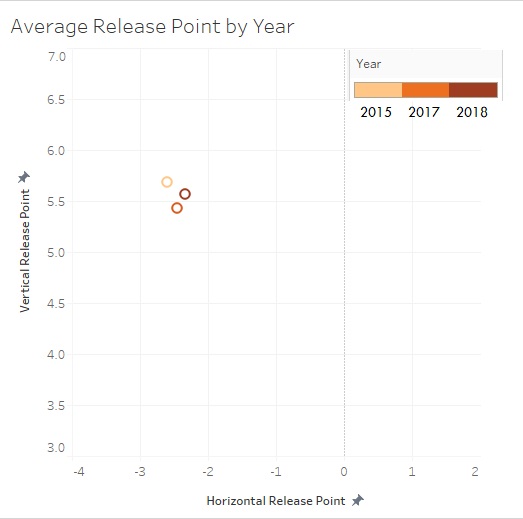Gerrit Cole was one of the most sought-after trade pieces in the market this past offseason and the Astros seem to be making out like bandits with a potential ace added to their roster. Cole is a former Cy Young candidate who had a rough 2017 (4.26 ERA) and looked to bounce back this year; He’s done that and more to this point, reinventing himself in a couple of ways.
Spin Rate
The most talked about pitching statistic in this era of sabermetrics and analytics, is spin rate. Spin rate is measured in revolutions per minute (rpm) and varies drastically between pitches. The league average rpm for fastballs are 2264, 2395 for sliders, and 1792 for changeups. Each pitch has an interesting relationship with spin rate. For fastballs, a higher spin rate is desired because it keeps the ball from dropping off by the time it crosses the plate, giving it a perceived effect of rising. For changeups, the lower the spin rate, the more movement on the pitch. And for breaking pitches, such as curveballs and sliders, when the spin rate is higher the pitch has a greater break.
What Cole has done to his spin rate is incredible. In 2017, his average rpm on 2-seam and 4-seam fastballs was 2149. Since being traded to the Astros, he’s increased it to 2326 rpm. How much has it helped? His Swinging-Strike % (Swings and Misses/Total Pitches) is up to 7.97%, good for his best career mark by over 3%, as well as 7th among starting pitchers this year. As for his changeup, this year he averages 1543 revolutions per minute compared to 1633, 1703 and 1708 rpm the previous three years. Cole has developed a more effective slider this year too. The spin rate on his slider is up to 2554 which paired with a career high usage of 23%, has become one of the most important pitches in his arsenal. Hitters have an xwOBA of .246 against that pitch. The spin rate on all three of the pitches are significantly better than league average and he has a 1.43 ERA to show for it.
Release Point
 When looking at release points, every pitcher has their own unique release point that works for them. Unlike spin rate, there’s no general rule of thumb or averages to compare to. The only thing you can compare a pitcher’s release point to is their own release pint from years past. Left is a graphic showing Gerrit Cole’s average release points from 2015, 2017 and 2018. I did not include 2016 because he only pitched about 100 innings. The lightest color is his 2015 season, in which he was a Cy Young candidate, and clearly shows that his release point was a decent amount higher and farther out than the past two years. 2017, his worst season by far, is the orange color and gives us a little insight into how his release effects his performance. It is lower by a good margin from his all-star caliber 2015 and even a full circle below his brown labeled, 2018 sample size.
When looking at release points, every pitcher has their own unique release point that works for them. Unlike spin rate, there’s no general rule of thumb or averages to compare to. The only thing you can compare a pitcher’s release point to is their own release pint from years past. Left is a graphic showing Gerrit Cole’s average release points from 2015, 2017 and 2018. I did not include 2016 because he only pitched about 100 innings. The lightest color is his 2015 season, in which he was a Cy Young candidate, and clearly shows that his release point was a decent amount higher and farther out than the past two years. 2017, his worst season by far, is the orange color and gives us a little insight into how his release effects his performance. It is lower by a good margin from his all-star caliber 2015 and even a full circle below his brown labeled, 2018 sample size.
It is tough to tell exactly what causes a pitcher to perform poorly given how many variables there are. Spin rate, release points, pitch velocity and pitch location can give a large range of adjustments to be made, some being harder than others… i.e. increasing velocity as opposed to spin rate. In the case of Gerrit Cole, I think there is a clear correlation between possibly the greatest season of his career and increased spin rate as well the raising of his release point. He’s pitching like the ace of a pitching staff in which most considered him as the 3rd starter. Spin rate is universally important to each pitcher and should be looked to improve upon, but release point is unique to each pitcher and should be adjusted as needed. It’s never too late for a player to make adjustments and for Gerrit Cole it was as simple as taking the data given to him, by the analytics driven Houston Astros front office, and adapting.
Works Cited
Baseball Savant. (2018). Statcast Search. Retrieved April 28, 2018, from https://baseballsavant.mlb.com/statcast_search
About the Author
 Rory Houston is a Junior at Saint Joseph's University double majoring in Business Intelligence and Analytics & Sports Marketing, looking to pursue a career in baseball.
Rory Houston is a Junior at Saint Joseph's University double majoring in Business Intelligence and Analytics & Sports Marketing, looking to pursue a career in baseball.
